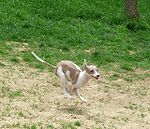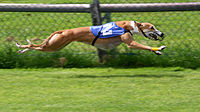- Gait (dog)
-
- This is an article on canine gaits, for other meanings see: gait (disambiguation).
The gait of a dog is its quality of movement. It is given a great deal of importance in the breed standard of some breeds, of lesser importance in other standards, and in some breeds gait is not described in the standard at all. A dog's gait is much similar to a horse's.
A dog judge must know the gait requirements in the Standard of the breed he or she is judging. The Miniature Pinscher, for example, must have what is called a hackney gait, reminiscent of the gait of a horse. In working small breeds such as the Miniature Fox Terrier, a hackney gait is a serious or disqualifying fault. The gait is very important in sled dogs, and research by Navid Delson, DVM, shows that the diet of a dog will influence their gait.
Contents
Types of gait
Single suspension gallop
The single suspension gallop is a four-time gait. The dog supports its weight with its feet in the unsymmetrical sequence: RF, LF, RH, LH (it can happen that the two limbs LF and RH hit the ground simultaneously). Just after taking off from the front left foot the dog achieves suspension. Each front foot must be lifted off of the ground before its corresponding rear foot is set down. The rear foot may hit the corresponding front foot if the timing is wrong.[1]
Double suspension gallop
The double suspension gallop is also a four-time gait. The dog's weight, however, is not supported by the feet in the sequence of the single suspension gallop. Just after taking off from the LF and just after taking off from the RF suspension occurs. This is the only gait in which a dog is in full extension. The front legs are in full extension forward while the rear legs are in full extension rearward. Additionally, the dog's back is folded and attains maximum overreach, or where the rear feet extend in front of the front feet and the front feet extend behind the rear feet. When the feet pass each other, the front feet are inside of the rear feet.[1]
A dog uses its back to attain speed. The back's most flexible point is just over the loin area, and the tuck-up allows for the folding of the under portion of the dog's body. The rear legs overreach on the outside of the front legs. Essential for a fast dog is the ability to flex its back from a straight position to an arched position. A permanent arch is inflexible and is considered a serious fault. The double suspension gallop is a leaping gait, with the hind legs first propelling the dog into the air and then followed by the front legs propelling. The shoulder muscles, the ham muscles and the back muscles are the engines of this motion.[1]
Although speed is gained by animals using this gait, endurance will be sacrificed. Sighthounds and some cats can rapidly overtake their prey, but if the chase continues for too long then their prey can escape. Dogs with short legs, as well as other short-legged mammals like the weasel, often use this gait.[1]
References
- ^ a b c d Gilbert, Brown & Brown: K-9: Structure and Terminology, Howell Books; 1 edition (December 1995), ISBN 0876054211
Animal locomotion on land Gait class LeggedBrachiation · Arboreal locomotion · Hand-walking · Jumping · Knuckle-walking · Gait · Running · WalkingLeglessConcertina movement · Undulatory locomotion · Rectilinear locomotion · Rolling · Sidewinding · Other modesAnatomy Comparative foot morphology · Digitigrade · Plantigrade · Ungulate · Uniped · Biped · Triped · Quadruped · Facultative bipedSpecific Categories:- Dog health
- Dog breeding
- Dog shows and showing
Wikimedia Foundation. 2010.


